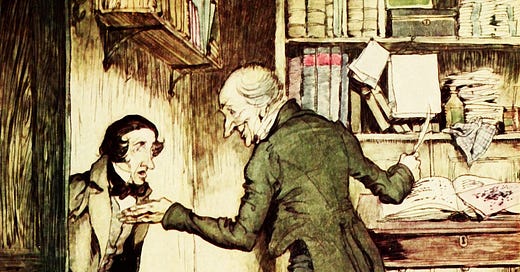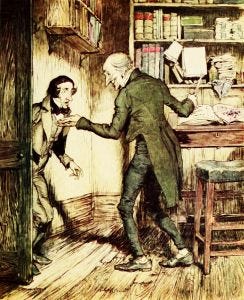For as long as I can remember, each Christmas, I have enjoyed watching the movie "Scrooge," based on the novella written by Charles Dickens and Starring Alistair Symm in the starring role of A Christmas Carol.
The novella contains dramatic symbolism. Each symbol echoes themes of redemption, transformation, and the enduring spirit of human kindness.
At the heart of this incredible story lies Scrooge, a miser warped by the clanging gears of materialism. His literal and metaphorical chains represent the shackles of greed and isolation, dragging him toward a bleak, lonely future. The ghosts act as guides, revealing to him the consequences of his choices.
First, there is The Ghost of Christmas Past, bathed in moonlight, which illuminates the wounds of Scrooge's past. There is the lost love of a woman, the neglected family, and his hardened heart. This journey through nostalgia is a potent symbol of memory's power, urging Scrooge to confront the roots of his desolation.
Second, there is The Ghost of Christmas Present, radiant and brimming with life, unveiling the joyful tapestry of the present. From the Cratchits' meager feast, overflowing with love, to the bustling streets alive with festive spirit, the ghost embodies the essence of Christmas: compassion, togetherness, and the simple pleasures of giving. The celebratory atmosphere starkly contrasts Scrooge's sterile existence, igniting a spark of empathy within him.
Finally, the shrouded Ghost of Christmas Yet to Come casts a chilling light on Scrooge's potential future. The grim visions of isolation and neglect serve as a chilling reminder of the path he is set upon. This prophetic journey symbolizes the inevitability of consequence and the urgency of change.
Dickens masterfully employs evocative imagery throughout the narrative to amplify his symbolic themes. The fireplace flickered warmly at the Cratchits' home but coldly in Scrooge's chambers. It signifies the contrasting warmth of generosity and the chilling isolation of avarice. From the meager Christmas goose to the overflowing feast Fezziwig prepared, food symbolizes shared joy and the abundance fostered by kindness.
Ultimately, "A Christmas Carol" is a testament to the transformative power of symbolism. Its rich tapestry of ghosts, memories, and festive imagery guides Scrooge and the reader through self-discovery. It reminds us that the ghosts of our choices haunt us all, that the present is a precious gift to be cherished, and that the uncertain future can be reshaped by acts of compassion and the embrace of the Christmas spirit.
Examining Some Psychoanalytic Interpretations
A Carl Jung Interpretation of the Symbols:
Carl Jung might see not just a Victorian ghost story but a profound exploration of the human psyche. Through Scrooge's transformation, he'd likely trace the battle between the conscious ego and the shadow, a realm holding both darkness and hidden potential.
Scrooge embodies the repressed shadow self. His miserliness is a symptom of a wounded heart, his isolation a barrier against vulnerability. The ghosts become Jungian archetypes, guiding forces from the collective unconscious.
The Ghost of Christmas Past, cloaked in the misty shadows of memory, confronts Scrooge with his neglected Anima, the lost love Belle. This encounter stirs the dormant well of emotions, forcing him to face the emotional wounds that drove him towards avarice.
The Ghost of Christmas Present, radiating warmth and vitality, embodies the archetype of the self, the totality of the psyche striving for wholeness. Witnessing the Cratchits' joyful poverty and the bustling festive spirit, Scrooge glimpses the possibility of connection and generosity, dormant facets of his true self.
Finally, the veiled Ghost of Christmas Yet to Come represents the archetype of the shadow's dark potential. The bleak visions of isolation and neglect are a chilling premonition of Scrooge's unlived life, a stark reminder of the consequences of neglecting the shadow's integration.
But Scrooge chooses transformation. His tears of remorse and his acts of compassion are symbols of the ego integrating the shadow's lessons. He embraces the Cratchits' Christmas, donates to needy people, and reconnects with his estranged family. It is an example of Jungian growth in action. At one time, rigid and self-serving, the conscious ego embraced the wholeness offered by the shadow's integration.
Dickens, through his evocative imagery, mirrors Jung's symbolism. The cold, clanging chains binding Scrooge represent the rigidity of the ego, while the festive warmth of the Cratchits' fire embodies the liberating embrace of the self.
Ultimately, "A Christmas Carol" becomes a Jungian morality tale, reminding us that neglecting the shadow is a recipe for isolation and despair. Through Scrooge's transformative journey, Jung might suggest confronting our darkness and integrating its lessons are the keys to embracing our true selves.
A Sigmund Freud Interpretation of the Symbols:
Sigmund Freud, the father of psychoanalysis, would interpret A Christmas Carol as a tale of the human psyche's struggle with the unconscious mind. He would argue that the story is rich in symbolism, and each symbol represents unconscious desires and conflicts.
He would interpret Scrooge as a personification of the human psyche's ego. The ego is the conscious part of the mind that deals with the external world. Because of his repressed unconscious desires, Scrooge's miserliness and isolation are a defense mechanism against the outer world.
Second, he would interpret the ghosts as representations of Scrooge's repressed desires. The Ghost of Christmas Past represents Scrooge's repressed childhood memories, including his lost love and broken family relationships. The Ghost of Christmas Present represents Scrooge's repressed desires for love, companionship, and generosity. Finally, the shrouded Ghost of Christmas Yet to Come represents Scrooge's repressed fears of death and the unknown.
Merry Christmas





“Confronting our darkness and integrating its lessons.” Well then, the secret to shedding old, unhealthy skin and rebuilding anew.
"...a wounded heart..." Yep, that's Scrooge. But life turned him that way.